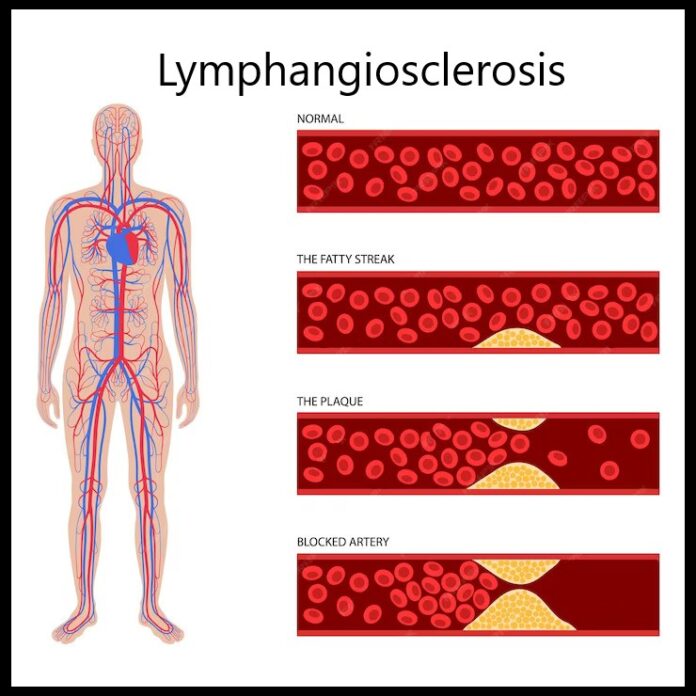Lymphangiosclerosis is a rare yet impactful lymphatic disorder that can significantly affect a person’s quality of life. Characterized by the hardening of lymph vessel walls, this condition can be a puzzle to diagnose and manage effectively. As you navigate through this comprehensive guide, you’ll gain insights into the causes, symptoms, and treatment options for lymphangiosclerosis and find guidance on living with and preventing this condition. Whether you are a patient, a caregiver, or simply seeking knowledge, this post is designed to empower and inform.
Unlocking Lymphangiosclerosis: A Startling Revelation
Lymphangiosclerosis, or lymphangiectasia, occurs when the lymphatic vessels—essential for fluid balance and immune response—dilate and harden. This process disrupts their normal function, leading to a buildup of lymph fluid, tissue swelling, and other associated symptoms. Despite being rare, the disorder can manifest in various ways and at different stages of life, making it crucial to understand its nuances.
Defining Lymphangiosclerosis: Causes and Context
The hardening of lymph vessel walls, a characteristic change in lymphangiosclerosis, is usually linked to chronic inflammation or a history of trauma to the lymphatic system. This condition may be primary, where the cause is unknown, genetic, or secondary, developing due to other health issues, such as venous insufficiency, obesity, or radiation therapy.
Understanding the roots of lymphangiosclerosis is paramount to its effective management. Medical investigations often trace the development of this condition back to the interconnected web of the body’s lymphatic and immune systems.
Causes that Count: Unveiling The Triggers
- Traumatic Injuries: Direct trauma or surgeries near the lymphatic system can disrupt its normal physiology and trigger lymphangiosclerosis.
- Obesity and Poor Nutrition: Excessive weight and poor diet can lead to inflammation, which, in turn, impacts the lymphatic vessels.
- Infections and Inflammation: Chronic infections or inflammatory conditions can lead to scarring and blockages in the lymphatic vessels.
- Genetic Predisposition: A familial history may sometimes indicate a genetic component to the condition.
Navigating the Complexity: Symptoms & Diagnosis
The symptoms of lymphangiosclerosis can be diverse, often leading to misdiagnosis or going unnoticed until the condition progresses. The early identification and understanding of these symptoms are crucial for prompt management.
Symptoms: The Body’s Cries for Attention
The telltale signs of lymphangiosclerosis include the development of hardened, thickened skin, particularly in the limbs or the trunk. Persistent swelling, known as lymphedema, can also occur. Additionally, patients may experience skin discoloration, recurring infections, and discomfort or pain in the affected area.
Diagnostic Dilemma: Understanding Lymphangiosclerosis Assessments
Due to its rarity and varied presentation, diagnosing lymphangiosclerosis can be challenging. Your healthcare provider may use a combination of physical examinations, imaging studies like lymphoscintigraphy or MRI, and biopsies to confirm the presence of the condition. Often, the persistence of symptoms and the exclusion of other potential causes lead to a final diagnosis.
The Healing Path: Treatment Approaches and Perspectives
Lymphangiosclerosis’s treatment journey is as varied as its symptoms, often requiring a bespoke approach that combines medical interventions with lifestyle modifications.
Medical Interventions: The Backbone of Treatment
- Compression Therapy: Wearing compression garments to support the affected limb and reduce swelling.
- Physical Therapy: Specialized exercises can help move the lymphatic fluid and manage the condition’s impact on mobility.
- Surgical Options: In severe cases, surgery may be necessary to improve lymphatic drainage and alleviate symptoms.
Self-Care and Lifestyle Adjustments: Crucial to Your Well-being
- Elevating Affected Limbs: Keeping the affected areas elevated can help reduce swelling.
- Skin Care: Maintaining proper skin hygiene and moisturization to prevent infections.
- Exercise and Movement: Regular physical activity can aid lymphatic drainage and overall health.
Prevention and Proactive Management: Your Role in the Fight Against Lymphangiosclerosis
While there is no surefire way to prevent lymphangiosclerosis, there are several steps individuals can take to manage their risk and support their overall lymphatic health.
Prevention Strategies: A Shield Against Lymphangiosclerosis
- Maintain a Healthy Weight: Obesity is a known risk factor for lymphangiosclerosis, so maintaining a healthy weight through diet and exercise is critical.
- Be Mindful of Trauma: Be cautious of injuries and seek prompt medical attention when needed, especially if they involve the limbs or the lymphatic system.
Managing Day-to-Day: Strategies for Living With Lymphangiosclerosis
- Stay Informed: Continually educate yourself about lymphangiosclerosis and how to manage your specific symptoms.
- Seek Out Support: Engage with healthcare professionals and support groups to share experiences and gather practical advice and emotional support.
- Be Consistent: Whether with your treatment plan or preventive measures, consistency breeds the most successful outcomes.
Conclusion: The Uphill Journey to Understanding and Managing Lymphangiosclerosis
Lymphangiosclerosis poses unique challenges due to its enigmatic nature. By being aware of the causes, recognizing the symptoms, and familiarizing yourself with the treatment modalities, you empower yourself to face the disorder head-on. Patient advocacy and research into better diagnostic tools and treatment options are paving the way for improved outcomes for those living with lymphangiosclerosis. It’s a collective effort that you, as a patient or a supporter, are an integral part of. Remain vigilant, knowledgeable, and most of all, optimistic.

